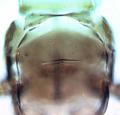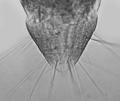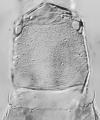Merothrips floridensis
Recognition data
Distinguishing features
Female usually wingless, rarely fully winged. Body, legs and antennae varying shades of light brown, head darkest. Antennae 8-segmented, segments all clearly distinct from each other and bearing long setae; apex of segments III and IV with transverse sensorium. Head small, eyes reduced to few ommatidia, vertex with one pair of long setae, also one pair of postocular setae well developed. Pronotum widest at posterior, with one pair of long posteroangular setae but few transverse lines of sculpture. Abdominal tergites with many transverse lines of sculpture; trichobothria on tergite X more than twice as wide as nearest setal base; ovipositor weak and non-serrate; sternites with 2–4 discal setae.
Male wingless; head with large pore plate; fore tibia sometimes with large sub-apical tubercle.
Variation
The body size of males varies considerably. Large males have expanded fore femora, the fore tibiae bear tubercles, and antennal segments III–IV are long and slender with almost straight, parallel sides. Small males have slender fore femora, the fore tibiae lack tubercles, and antennal segments III–IV are shorter with convex margins. The body color, and the extent of the sculpture near the posterior margin of the pronotum varies between populations (Mound & O’Neill, 1974).
Related and similar species
A total of 13 extant species are listed in the genus Merothrips, all from the warmer parts of the world. The eastern North American species Merothrips morgani Hood is similar in general body form to M. floridensis, but has distinctively curved sculpture lines on the median area of the pronotum; no specimens have been seen from west of Texas. M. laevis Hood is particularly similar to M. floridensis, but lacks sculpture on the abdominal tergites.
Taxonomic data
Current valid name
Merothrips floridensis Watson
Original name and synonyms
- Merothrips floridensis Watson, 1927: 60
- Merothrips capensis Faure, 1938: 6
- Merothrips plaumanni Crawford, 1942: 152
- Merothrips xylophilus zur Strassen, 1959: 447
- Merothrips priesneri Bournier, 1960: 98
- Merothrips zondagi Ward, 1969: 359
Family placement
Merothripidae
Biological data
Life history
Breeding primarily in leaf litter rather than on dead twigs.
Host plants
Fungivorous.
Tospoviruses vectored
None
Crop damage
None
Distribution data
Area of origin
Possibly Caribbean area
Distribution
Widespread from Georgia, Kentucky and Florida, through Central America to southern Brazil. Also known from California, Hawaii, Japan, Australia, New Zealand, South Africa, Azores and southern France (Mound & O'Neill, 1974).








